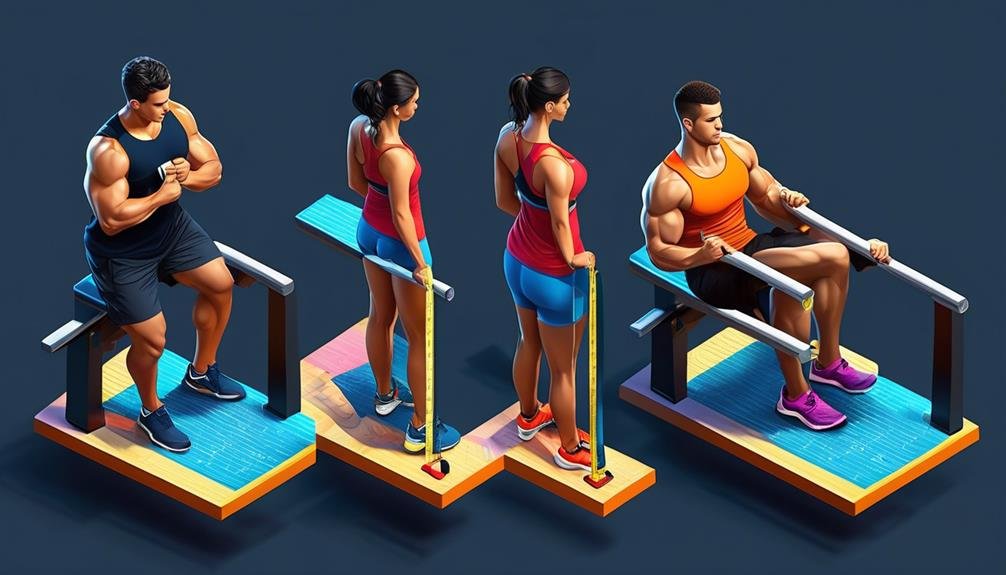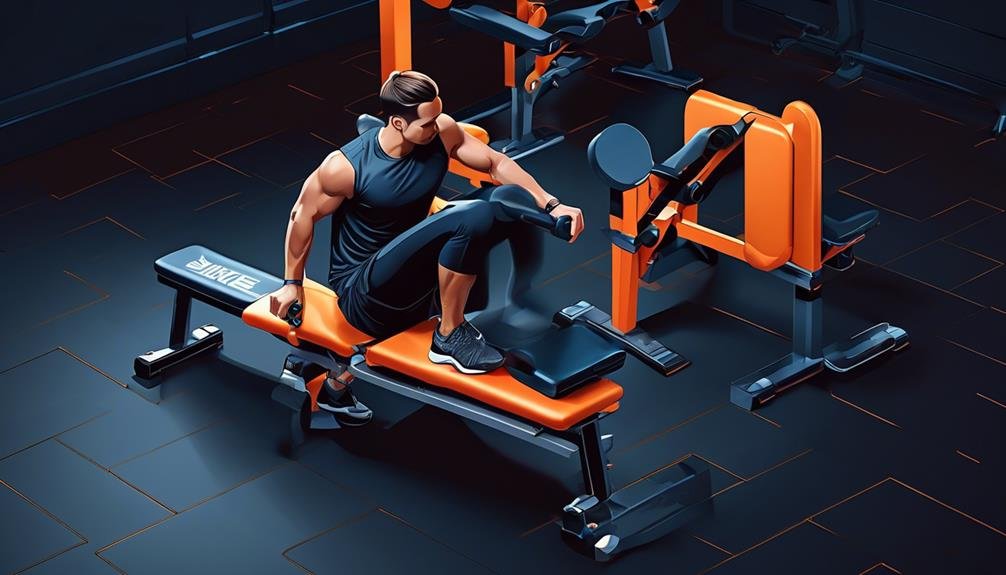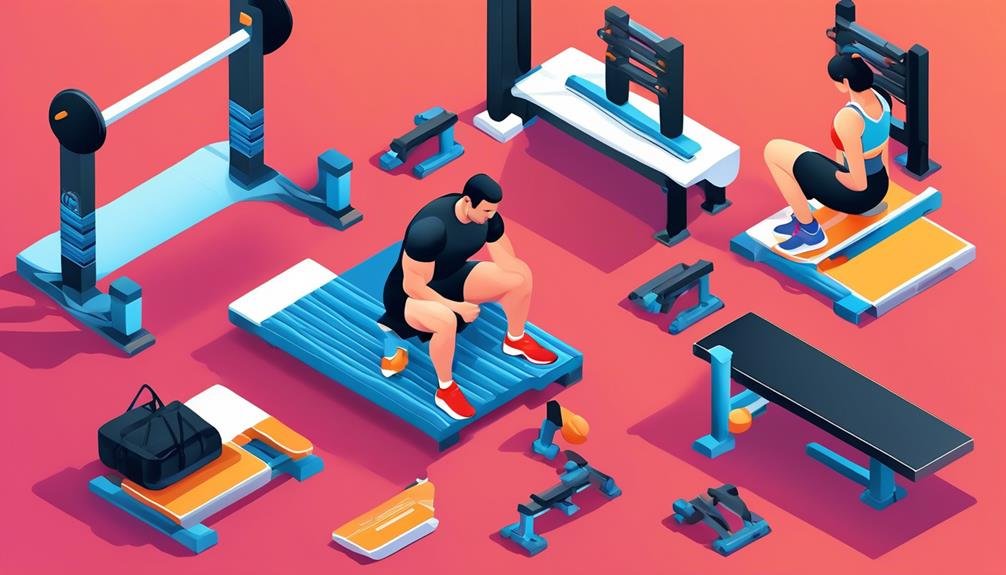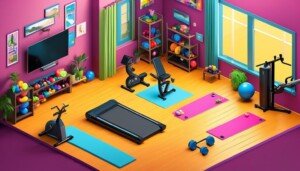Imagine this scenario: you're at the gym, ready to tackle your workout routine. You approach the workout bench, but as you prepare to lift, you find yourself questioning if the bench height is right for you.
Don't worry, you're not alone. Determining the proper workout bench height is crucial for optimal performance and preventing injuries.
In this discussion, we will explore the factors to consider when determining the right bench height for you, how to measure your own body proportions, and the adjustability options available.
So, let's dive in and ensure you have the perfect bench height to support your fitness goals.
Key Takeaways
- Proper workout bench height is important for maintaining correct form, optimizing muscle engagement, and minimizing the risk of injury.
- Different types of benches have optimal height ranges for specific exercises, so it's crucial to choose the right bench height for each exercise.
- Measuring your body proportions, such as torso length, arm length, leg length, shoulder width, and hip width, can help determine the appropriate bench height for your individual needs.
- Adjustable benches offer customization options based on body proportions and the specific exercise being performed, allowing for proper alignment and support.
Importance of Proper Workout Bench Height
Proper workout bench height is crucial for maintaining correct form, optimizing muscle engagement, and minimizing the risk of injury during exercises.
When it comes to working out at the gym, one of the most important factors to consider is the height of your workout bench. The height of the bench directly affects your range of motion, which is the distance your joints can move during an exercise.
By setting the bench at the appropriate height, you can ensure that you're able to perform exercises with the correct form, allowing for maximum muscle engagement and effectiveness.
An adjustable bench is highly recommended because it allows you to customize the height based on your individual needs. This versatility is essential as it enables you to adapt the bench to different exercises and body positions, ensuring optimal muscle activation.
Without the proper height, you may find yourself in uncomfortable positions that hinder your performance and increase the risk of injury.
Factors to Consider When Determining Bench Height
When determining the bench height for your workout, there are several important factors to take into consideration.
The first factor is the type of bench you'll be using. There are different types of workout benches available, such as flat benches, utility benches, and adjustable benches. Each type has its own optimal height range for performing various exercises.
For the flat bench, which is commonly used for exercises like the bench press, the ideal height is when your feet are flat on the ground and your knees are at a 90-degree angle. This ensures proper stability and positioning for the exercise.
The utility bench, which can be adjusted to different incline angles, requires a slightly different approach. For exercises like the chest press, the bench should be set at a height that allows your feet to be firmly on the ground, your knees to be slightly bent, and your thighs to be parallel to the floor. This position provides optimal stability and proper alignment of the muscles being worked.
Lastly, adjustable benches offer the flexibility to perform a wide range of exercises at different angles. When determining the bench height for these benches, it's important to consider the specific exercise you'll be performing and adjust the bench accordingly to ensure proper form and alignment.
Measuring Your Own Body Proportions

Have you ever wondered how to accurately measure your own body proportions for determining the right workout bench height?
To ensure proper alignment and support during your workouts, it's crucial to measure your body correctly.
First, measure your torso length from the base of your spine to the top of your head. This measurement will help you find a workout bench that aligns with your height and provides adequate support for your back.
Next, measure the length of your arms from your shoulder to your fingertips. This measurement is essential for determining the bench height that allows for proper arm positioning and range of motion.
Additionally, consider the length of your legs from your hips to your feet. This measurement will help you find a bench that allows for proper foot placement and stability.
Lastly, take into account the width of your shoulders and hips. These measurements will help you choose a bench that accommodates your body's width and provides optimal comfort.
Adjustability Options for Workout Benches
Adjustability options for workout benches can greatly enhance your exercise routine by allowing you to customize the bench to your specific needs and preferences. These options provide flexibility and adaptability, ensuring that you can achieve the correct workout bench height for optimal performance and comfort. Here are three key adjustability options that you should consider:
- Height adjustment: Many workout benches offer the ability to adjust the height of the seat or backrest. This feature allows you to find the perfect height that matches your body proportions, ensuring proper alignment and support during your exercises.
- Angle adjustment: Some benches provide adjustable angles for the backrest or seat. This allows you to change the incline or decline of the bench, providing different levels of challenge and targeting specific muscle groups. Adjusting the angle can also help alleviate strain on your joints and back.
- Attachment compatibility: Look for benches that are compatible with various attachments and accessories. These attachments can include leg developers, preacher curl attachments, or even racks for holding weights. Having the option to add attachments allows you to customize your workout bench to meet your specific exercise requirements and goals.
Ergonomics and Comfort for Optimal Performance

To optimize your performance and ensure maximum comfort during your workout routine, it is crucial to consider the ergonomics and comfort of the workout bench, building upon the adjustability options previously discussed. The workout bench height, in particular, plays a significant role in achieving optimal performance.
When it comes to ergonomics, the workout bench height should be suitable for proper leg drive and setup, especially during exercises like the bench press. Having the correct height allows for a stable and efficient lifting motion, minimizing the risk of injury and maximizing your strength gains.
Comfort is equally important for a satisfying workout experience. Look for a workout bench with padding that strikes a balance between comfort and stability. Too much cushioning can affect your stability, while too little can lead to discomfort and even pain. It's essential to find the right level of padding that provides adequate support without compromising your stability and safety.
To further enhance your convenience and workout experience, consider additional features like a foldable design, transport wheels, or built-in storage. These features can make it easier to store and move the bench, allowing you to optimize your workout space and streamline your routine.
By prioritizing ergonomics and comfort in your choice of workout bench, you can optimize your performance, minimize the risk of injury, and have a more enjoyable and effective workout session. Take the time to find a bench that meets your specific needs and preferences, and you'll be well on your way to achieving your fitness goals.
| Ergonomics | Comfort | Convenience |
|---|---|---|
| Suitable height | Balanced padding | Foldable design |
| Proper leg drive | Stable and secure | Transport wheels |
| Efficient setup | Minimal discomfort | Built-in storage |
| Optimal lifting | Supportive |
Safety Precautions to Prevent Injuries
To prevent injuries during your workout routine, it's crucial to follow safety precautions. Here are three important safety measures to keep in mind when using workout benches:
- Proper warm-up: Always start your workout with a proper warm-up to prepare your muscles and prevent strains or tears. This can include dynamic stretches, light cardio exercises, and mobility drills. A warm-up increases blood flow to your muscles, improves flexibility, and reduces the risk of injury.
- Use a spotter or safety bars: When lifting heavy weights on a workout bench, it's essential to have a spotter or safety bars in place. A spotter can assist you in case you struggle with the weight, while safety bars can stop the barbell from falling onto your chest or neck. These safety measures ensure that you can safely push yourself without risking injury.
- Maintain proper form and technique: Improper form and technique can lead to muscle strains and injuries. It's crucial to learn the correct form for each exercise and focus on maintaining it throughout your workout. This includes keeping your back straight, engaging your core, and using the correct range of motion. Paying attention to form helps to minimize stress on your joints and prevents unnecessary strain on your muscles.
Frequently Asked Questions
How High Should My Workout Bench Be?
To determine the right workout bench height for you, consider your height, exercise goals, and comfort. Height recommendations vary, but a general rule is to aim for a bench height that allows your knees to be at a 90-degree angle when seated.
How High Should My Bench Bar Be?
To determine the right height for your bench bar, stand with your feet flat on the ground, knees slightly bent. The bar should be at a comfortable height, allowing you to maintain proper form during your exercises.
How Do I Choose a Workout Bench?
To choose a workout bench, consider your body type, exercise goals, and comfort. Look for a bench with adjustable height options and proper padding for support. Test different benches to find the one that suits you best.
Does Height Matter in Bench Press?
Height matters in bench press as it affects your form and performance. A bench that is too low or high can hinder leg drive and chest press technique. Look for adjustable benches to accommodate your individual anatomy and exercise needs.
Conclusion
In conclusion, determining the right workout bench height is crucial for ensuring stability, comfort, and optimal performance during exercises.
By considering factors such as foot placement, back and head support, bench width, and personal height, you can find the perfect bench height for your needs.
Additionally, adjustable options and ergonomic designs can further enhance your workout experience.
Prioritizing safety and proper form will help prevent injuries and maximize your fitness gains.





